
The Golden Hill Bridge is a historic bridge on Golden Hill Road over the Housatonic River in Lee, Massachusetts. It is a lenticular pony truss bridge built c. 1885 by the Berlin Iron Bridge Company, and is the state's oldest surviving bridge of this type. It is one of only five Berlin Co. bridges in the Berkshires, and is the only known surviving bridge to implement modifications to the pony truss design patented by William O. Douglas in 1885. The bridge was listed on the National Register of Historic Places in 1994.

The Hadley Parabolic Bridge, often referred to locally as the Hadley Bow Bridge, carries Corinth Road across the Sacandaga River in Hadley, New York, United States. It is an iron bridge dating from the late 19th century.
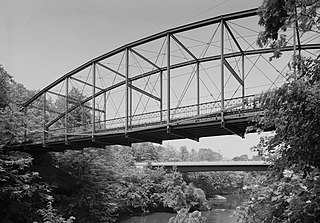
The Lover's Leap Bridge is a wrought-iron lenticular truss bridge over the Housatonic River located in Lovers Leap State Park in New Milford, Connecticut. Built in 1895 by the Berlin Iron Bridge Company, it is one of the last bridges built by the company and is a particularly ornate example of its work. It was listed on the National Register of Historic Places in 1976 and is now open only for foot traffic.

The Glen Falls Bridge is a historic bridge that formerly carried Brunswick Avenue over the Moosup River in Plainfield, Connecticut. Built in 1886 by the Berlin Iron Bridge Company, it is one of a shrinking number of surviving 19th-century lenticular truss bridges in the state. The bridge was listed on the National Register of Historic Places in 1999. It has been closed to all traffic for many years.

Ouaquaga Lenticular Truss Bridge is a historic lenticular truss bridge located at Ouaquaga in the towns of Windsor and Colesville in Broome County, New York. It was constructed in 1888 and spans the Susquehanna River. It is composed of two identical through trusses with an overall length of 343 feet (105 m). It was constructed by the Berlin Iron Bridge Co. of East Berlin, Connecticut. The bridge was closed to vehicular traffic in 2008 when a new bridge was built alongside it. The old bridge remains open for pedestrian use.
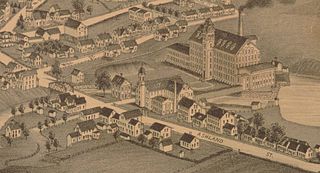
The Ashland Mill Bridge was a lenticular pony truss bridge over the Pachaug River in Griswold, Connecticut that was built in 1886 by the Berlin Iron Bridge Company. It was built following the Ashland dam break of February 1886 which washed away the previous bridges. The bridge served the millyard of the Ashland Cotton Company, in the Jewett City section of Griswold. The bridge was 65 feet (20 m) long and crossed a millrace on a skew angle. The Ashland Mill was damaged by arson in March 1995 and subsequently torn down, but the bridge itself remained. By 1999, the town deemed the bridge unsafe and closed it, and by February 1999, the bridge was moved to a vacant parking lot and was replaced with a new bridge. The bridge was added to the state of Connecticut historic register and it was later added to the National Register of Historic Places in April 1999. It was removed from the National Register in February 2016.

The Turn-of-River Bridge, also known as Old North Stamford Road Bridge, is a single-span lenticular pony truss bridge built by the Berlin Iron Bridge Company in 1892. It was listed on the National Register of Historic Places in 1987. It formerly brought the Old Stamford Road across the Rippowam River, but is now open only to pedestrian traffic, as the road ends shortly before the bridge.

The Berlin Iron Bridge Company was a Berlin, Connecticut company that built iron bridges and buildings that were supported by iron. It is credited as the architect of numerous bridges and buildings now listed on the U.S. National Register of Historic Places. It eventually became part of the American Bridge Company.

The Main Street Bridge formerly carried Main Street over the Rippowam River just outside downtown Stamford, Connecticut. It was designed and manufactured by the Berlin Iron Bridge Company in 1888. It is a two-span wrought iron lenticular truss bridge, each span 60 feet (18 m) long, although there are supporting piers every 12 feet (3.7 m) feet. The abutments and central pier are cut granite and other stone, faced in concrete.

Ruhle Road Lenticular Metal Truss Bridge is a historic Lenticular truss bridge located in Malta, Saratoga County, New York. It was constructed in 1888 by the Berlin Iron Bridge Company of East Berlin, Connecticut, and originally spanned the Black Creek in Salem, Washington County, New York.

The Butts Bridge carries Butts Bridge Road over the Quinebaug River in the town of Canterbury, Connecticut. It is a well-preserved example of a Parker truss, built in 1937, late in the state's regular use of steel truss bridge designs. The bridge is also known as Bridge No. 1649 and carries an average of 2,300 vehicles per day as of 2011. It was listed on the National Register of Historic Places in 2010.

The Crossman Bridge, also known as the Gilbert Road Bridge, is a truss bridge located in Warren, Massachusetts, carrying Gilbert Road across the Quaboag River. Built in 1888 and rehabilitated in 2004–08, it is one of the few surviving lenticular truss bridges in Massachusetts, and the only known lenticular pony truss bridge. The bridge was added to the National Register of Historic Places in 2010.
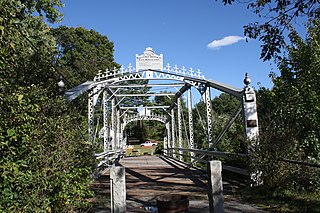
The Pineground Bridge, also known as the Depot Road Bridge or the Thunder Bridge, is a through-type lenticular truss bridge that formerly carried Depot Road over the Suncook River in Chichester, New Hampshire. The bridge was built in 1887 by the Berlin Iron Bridge Co., and is the only one of its type in the state. It is 96 feet (29 m) long and 16 feet (4.9 m) wide, and rises 15 feet (4.6 m) above the river. It is mounted on abutments made of unmortared ashlar granite. The decking and rails are made of wood. The bridge has not undergone major alterations since its construction. Some of its stringers were replaced during the 1981-2 restoration, wooden parts were also replaced, and a number of decorative parts have been lost over the years.
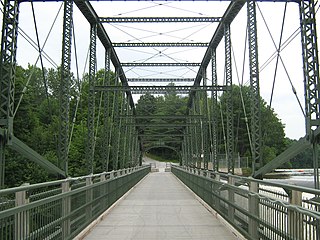
The Douglas & Jarvis Patent Parabolic Truss Iron Bridge is a historic bridge across the Missisquoi River in Highgate, Vermont. Located at the end of Mill Hill Road, it is at 215 feet (66 m) one of the longest bridges of its type in the northeastern United States. It was built in 1887, and was listed on the National Register of Historic Places in 1974.

The Old Boardman Bridge, formerly Boardman Bridge, is a historic lenticular truss bridge, which used to carry Boardman Road across the Housatonic River in New Milford, Connecticut. Built from 1887 to 1888 out of wrought iron, it is one of the state's three surviving examples of this bridge type, and along with Lover's Leap Bridge, one of two in New Milford. It was listed on the National Register of Historic Places in 1976. The bridge was closed to vehicles in 1984 and to pedestrians in 1985; however, the Town of New Milford is seeking to restore it and reopen it to pedestrian traffic.

The Minortown Road Bridge is a historic lenticular pony truss bridge in northeastern Woodbury, Connecticut. It spans the Nonewaug River, connecting U.S. Route 6 (US 6) to Minortown Road and Mill Road. Built in 1890 by the Berlin Iron Bridge Company, it is one a small number of surviving lenticular truss bridges in the state. It was listed on the National Register of Historic Places in 2001.

The Town Bridge is a historic truss bridge, carrying Town Bridge Road over the Farmington River in Canton, Connecticut. Built in 1895, it is one of only two surviving pin-connected Parker truss bridges in the state. It was listed on the National Register of Historic Places in 1999.
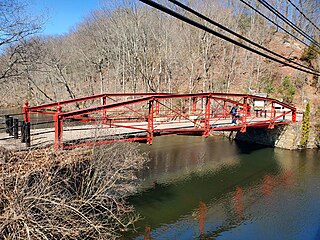
The Red Bridge is a historic bridge spanning the Quinnipiac River near Oregon Road in Meriden, Connecticut. It was built in 1891 by the Berlin Iron Bridge Company, and is one of a small number of surviving lenticular truss bridges in the state, and was listed on the National Register of Historic Places in 1993. The bridge is open to pedestrian traffic only.

The Sheffield Street Bridge is a historic lenticular truss bridge spanning Hancock Brook in Waterbury, Connecticut, United States. Built in 1884, it is a rare example of a wrought iron bridge built by the Berlin Iron Bridge Co., and one of the few surviving lenticular truss bridges left in the state. It was listed on the National Register of Historic Places in 2001.

The Washington Avenue Bridge is a historic lenticular truss bridge carrying Washington Avenue over the Mad River in Waterbury, Connecticut. Built in 1881, it is the oldest known surviving example of a lenticular pony truss bridge built by the Corrugated Metal Company, later known as the Berlin Iron Bridge Company, a prolific bridge maker in New England of the late 19th century. The bridge was listed on the National Register of Historic Places in 2001.





















